Finance Accounting Assignment: Analysis of Financial Statements
VerifiedAdded on 2022/10/09
|8
|2579
|18
Homework Assignment
AI Summary
This finance accounting assignment solution provides a detailed analysis of financial statements, covering topics such as current and non-current liabilities, net debt, provisions for employee benefits and lease payments, and the implications of interest rate swaps and caps. The assignment delves into the composition and changes in current liabilities, including trade payables, deferred revenue, and provisions, highlighting the company's risk management strategies. It also examines non-current liabilities, including bank loans and hedging activities, as well as the impact of deferred tax liabilities and the differences between corporate and partnership accounting. The solution further explores the treatment of profit distribution, equity capital, and the cash flow statement, comparing the practices of a company and a partnership. The analysis includes discussion of IAS 37, and IAS 7, providing a comprehensive overview of the financial aspects discussed in the assignment.
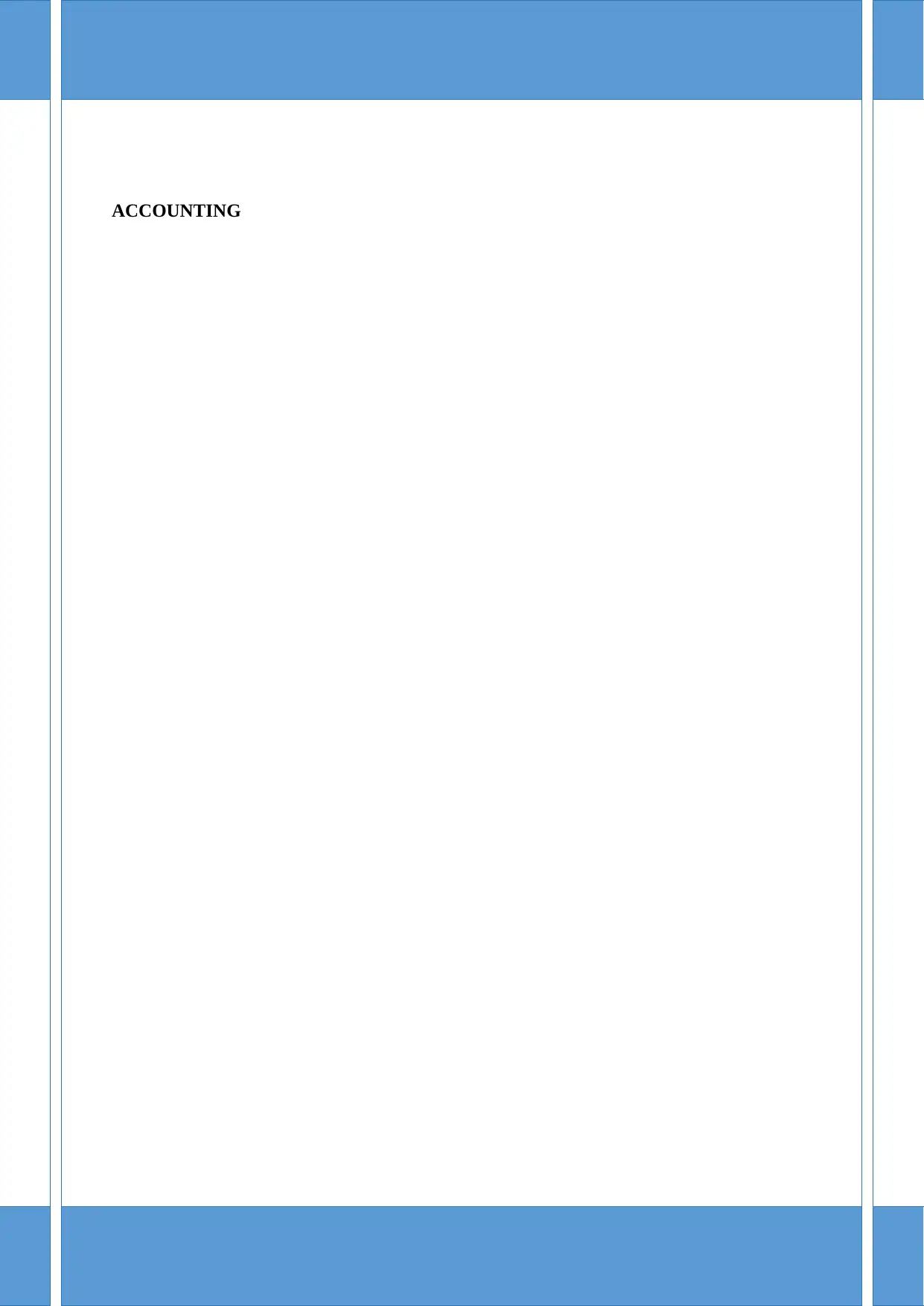
ACCOUNTING
Paraphrase This Document
Need a fresh take? Get an instant paraphrase of this document with our AI Paraphraser
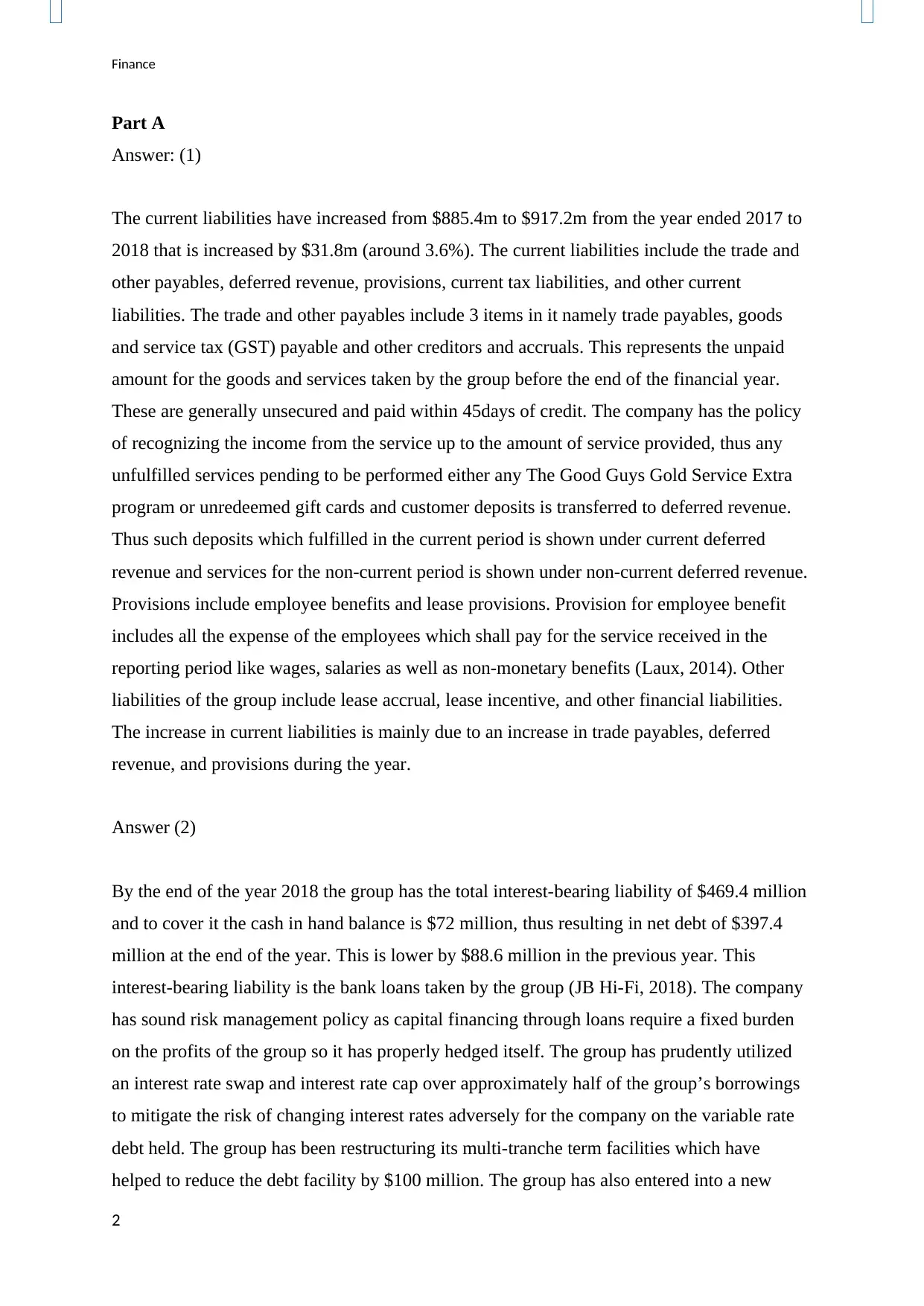
Finance
Part A
Answer: (1)
The current liabilities have increased from $885.4m to $917.2m from the year ended 2017 to
2018 that is increased by $31.8m (around 3.6%). The current liabilities include the trade and
other payables, deferred revenue, provisions, current tax liabilities, and other current
liabilities. The trade and other payables include 3 items in it namely trade payables, goods
and service tax (GST) payable and other creditors and accruals. This represents the unpaid
amount for the goods and services taken by the group before the end of the financial year.
These are generally unsecured and paid within 45days of credit. The company has the policy
of recognizing the income from the service up to the amount of service provided, thus any
unfulfilled services pending to be performed either any The Good Guys Gold Service Extra
program or unredeemed gift cards and customer deposits is transferred to deferred revenue.
Thus such deposits which fulfilled in the current period is shown under current deferred
revenue and services for the non-current period is shown under non-current deferred revenue.
Provisions include employee benefits and lease provisions. Provision for employee benefit
includes all the expense of the employees which shall pay for the service received in the
reporting period like wages, salaries as well as non-monetary benefits (Laux, 2014). Other
liabilities of the group include lease accrual, lease incentive, and other financial liabilities.
The increase in current liabilities is mainly due to an increase in trade payables, deferred
revenue, and provisions during the year.
Answer (2)
By the end of the year 2018 the group has the total interest-bearing liability of $469.4 million
and to cover it the cash in hand balance is $72 million, thus resulting in net debt of $397.4
million at the end of the year. This is lower by $88.6 million in the previous year. This
interest-bearing liability is the bank loans taken by the group (JB Hi-Fi, 2018). The company
has sound risk management policy as capital financing through loans require a fixed burden
on the profits of the group so it has properly hedged itself. The group has prudently utilized
an interest rate swap and interest rate cap over approximately half of the group’s borrowings
to mitigate the risk of changing interest rates adversely for the company on the variable rate
debt held. The group has been restructuring its multi-tranche term facilities which have
helped to reduce the debt facility by $100 million. The group has also entered into a new
2
Part A
Answer: (1)
The current liabilities have increased from $885.4m to $917.2m from the year ended 2017 to
2018 that is increased by $31.8m (around 3.6%). The current liabilities include the trade and
other payables, deferred revenue, provisions, current tax liabilities, and other current
liabilities. The trade and other payables include 3 items in it namely trade payables, goods
and service tax (GST) payable and other creditors and accruals. This represents the unpaid
amount for the goods and services taken by the group before the end of the financial year.
These are generally unsecured and paid within 45days of credit. The company has the policy
of recognizing the income from the service up to the amount of service provided, thus any
unfulfilled services pending to be performed either any The Good Guys Gold Service Extra
program or unredeemed gift cards and customer deposits is transferred to deferred revenue.
Thus such deposits which fulfilled in the current period is shown under current deferred
revenue and services for the non-current period is shown under non-current deferred revenue.
Provisions include employee benefits and lease provisions. Provision for employee benefit
includes all the expense of the employees which shall pay for the service received in the
reporting period like wages, salaries as well as non-monetary benefits (Laux, 2014). Other
liabilities of the group include lease accrual, lease incentive, and other financial liabilities.
The increase in current liabilities is mainly due to an increase in trade payables, deferred
revenue, and provisions during the year.
Answer (2)
By the end of the year 2018 the group has the total interest-bearing liability of $469.4 million
and to cover it the cash in hand balance is $72 million, thus resulting in net debt of $397.4
million at the end of the year. This is lower by $88.6 million in the previous year. This
interest-bearing liability is the bank loans taken by the group (JB Hi-Fi, 2018). The company
has sound risk management policy as capital financing through loans require a fixed burden
on the profits of the group so it has properly hedged itself. The group has prudently utilized
an interest rate swap and interest rate cap over approximately half of the group’s borrowings
to mitigate the risk of changing interest rates adversely for the company on the variable rate
debt held. The group has been restructuring its multi-tranche term facilities which have
helped to reduce the debt facility by $100 million. The group has also entered into a new
2
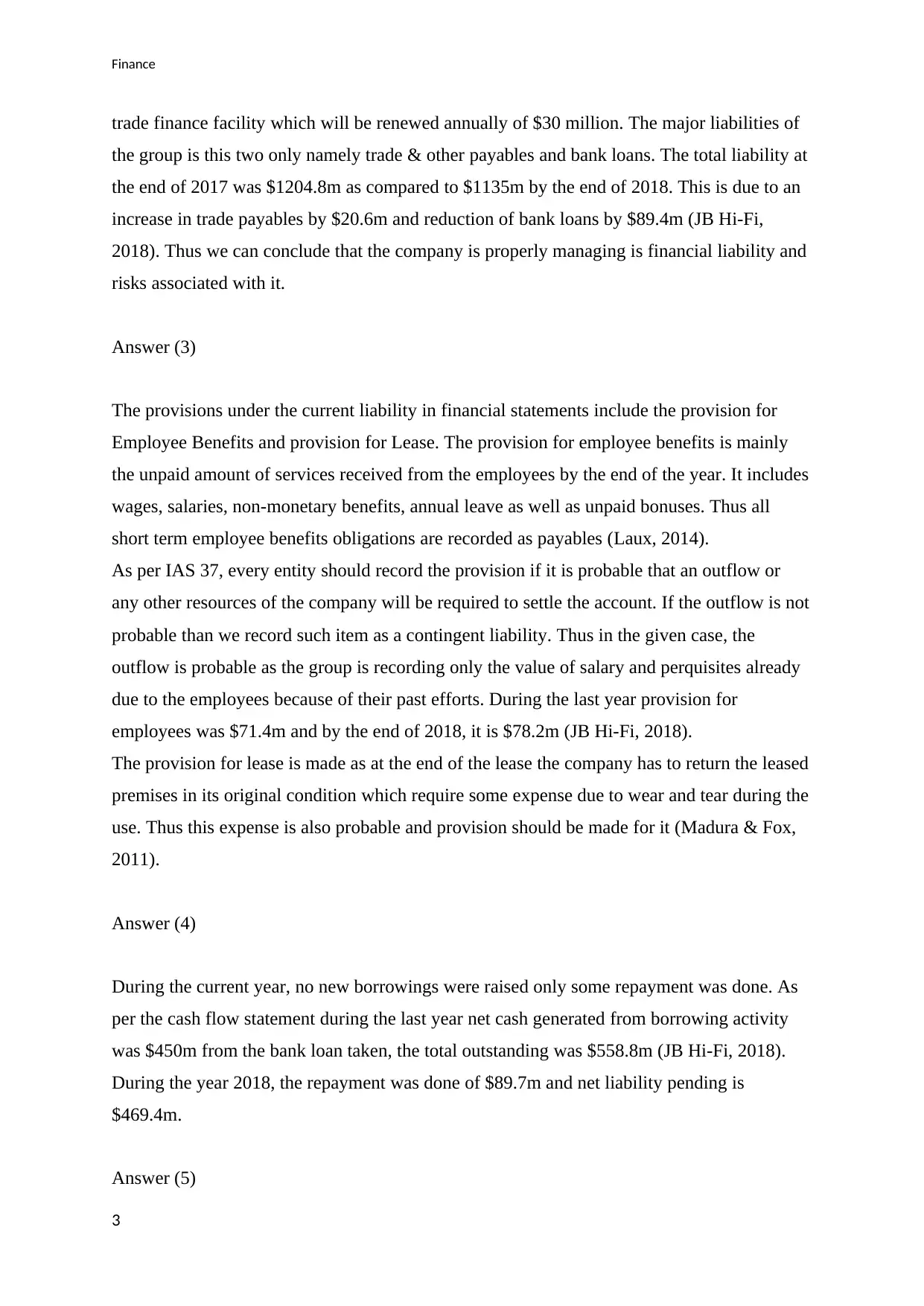
Finance
trade finance facility which will be renewed annually of $30 million. The major liabilities of
the group is this two only namely trade & other payables and bank loans. The total liability at
the end of 2017 was $1204.8m as compared to $1135m by the end of 2018. This is due to an
increase in trade payables by $20.6m and reduction of bank loans by $89.4m (JB Hi-Fi,
2018). Thus we can conclude that the company is properly managing is financial liability and
risks associated with it.
Answer (3)
The provisions under the current liability in financial statements include the provision for
Employee Benefits and provision for Lease. The provision for employee benefits is mainly
the unpaid amount of services received from the employees by the end of the year. It includes
wages, salaries, non-monetary benefits, annual leave as well as unpaid bonuses. Thus all
short term employee benefits obligations are recorded as payables (Laux, 2014).
As per IAS 37, every entity should record the provision if it is probable that an outflow or
any other resources of the company will be required to settle the account. If the outflow is not
probable than we record such item as a contingent liability. Thus in the given case, the
outflow is probable as the group is recording only the value of salary and perquisites already
due to the employees because of their past efforts. During the last year provision for
employees was $71.4m and by the end of 2018, it is $78.2m (JB Hi-Fi, 2018).
The provision for lease is made as at the end of the lease the company has to return the leased
premises in its original condition which require some expense due to wear and tear during the
use. Thus this expense is also probable and provision should be made for it (Madura & Fox,
2011).
Answer (4)
During the current year, no new borrowings were raised only some repayment was done. As
per the cash flow statement during the last year net cash generated from borrowing activity
was $450m from the bank loan taken, the total outstanding was $558.8m (JB Hi-Fi, 2018).
During the year 2018, the repayment was done of $89.7m and net liability pending is
$469.4m.
Answer (5)
3
trade finance facility which will be renewed annually of $30 million. The major liabilities of
the group is this two only namely trade & other payables and bank loans. The total liability at
the end of 2017 was $1204.8m as compared to $1135m by the end of 2018. This is due to an
increase in trade payables by $20.6m and reduction of bank loans by $89.4m (JB Hi-Fi,
2018). Thus we can conclude that the company is properly managing is financial liability and
risks associated with it.
Answer (3)
The provisions under the current liability in financial statements include the provision for
Employee Benefits and provision for Lease. The provision for employee benefits is mainly
the unpaid amount of services received from the employees by the end of the year. It includes
wages, salaries, non-monetary benefits, annual leave as well as unpaid bonuses. Thus all
short term employee benefits obligations are recorded as payables (Laux, 2014).
As per IAS 37, every entity should record the provision if it is probable that an outflow or
any other resources of the company will be required to settle the account. If the outflow is not
probable than we record such item as a contingent liability. Thus in the given case, the
outflow is probable as the group is recording only the value of salary and perquisites already
due to the employees because of their past efforts. During the last year provision for
employees was $71.4m and by the end of 2018, it is $78.2m (JB Hi-Fi, 2018).
The provision for lease is made as at the end of the lease the company has to return the leased
premises in its original condition which require some expense due to wear and tear during the
use. Thus this expense is also probable and provision should be made for it (Madura & Fox,
2011).
Answer (4)
During the current year, no new borrowings were raised only some repayment was done. As
per the cash flow statement during the last year net cash generated from borrowing activity
was $450m from the bank loan taken, the total outstanding was $558.8m (JB Hi-Fi, 2018).
During the year 2018, the repayment was done of $89.7m and net liability pending is
$469.4m.
Answer (5)
3
⊘ This is a preview!⊘
Do you want full access?
Subscribe today to unlock all pages.

Trusted by 1+ million students worldwide
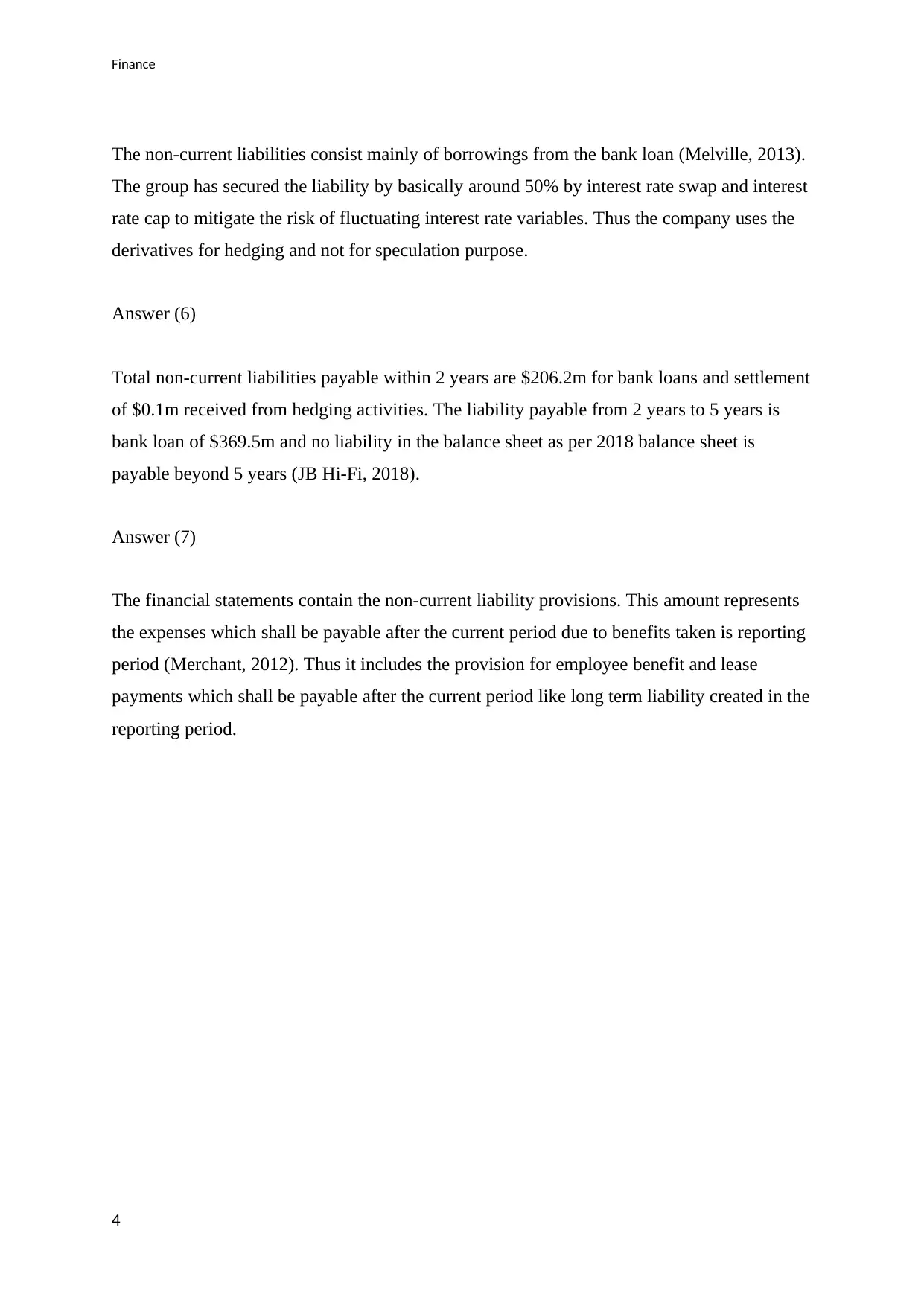
Finance
The non-current liabilities consist mainly of borrowings from the bank loan (Melville, 2013).
The group has secured the liability by basically around 50% by interest rate swap and interest
rate cap to mitigate the risk of fluctuating interest rate variables. Thus the company uses the
derivatives for hedging and not for speculation purpose.
Answer (6)
Total non-current liabilities payable within 2 years are $206.2m for bank loans and settlement
of $0.1m received from hedging activities. The liability payable from 2 years to 5 years is
bank loan of $369.5m and no liability in the balance sheet as per 2018 balance sheet is
payable beyond 5 years (JB Hi-Fi, 2018).
Answer (7)
The financial statements contain the non-current liability provisions. This amount represents
the expenses which shall be payable after the current period due to benefits taken is reporting
period (Merchant, 2012). Thus it includes the provision for employee benefit and lease
payments which shall be payable after the current period like long term liability created in the
reporting period.
4
The non-current liabilities consist mainly of borrowings from the bank loan (Melville, 2013).
The group has secured the liability by basically around 50% by interest rate swap and interest
rate cap to mitigate the risk of fluctuating interest rate variables. Thus the company uses the
derivatives for hedging and not for speculation purpose.
Answer (6)
Total non-current liabilities payable within 2 years are $206.2m for bank loans and settlement
of $0.1m received from hedging activities. The liability payable from 2 years to 5 years is
bank loan of $369.5m and no liability in the balance sheet as per 2018 balance sheet is
payable beyond 5 years (JB Hi-Fi, 2018).
Answer (7)
The financial statements contain the non-current liability provisions. This amount represents
the expenses which shall be payable after the current period due to benefits taken is reporting
period (Merchant, 2012). Thus it includes the provision for employee benefit and lease
payments which shall be payable after the current period like long term liability created in the
reporting period.
4
Paraphrase This Document
Need a fresh take? Get an instant paraphrase of this document with our AI Paraphraser
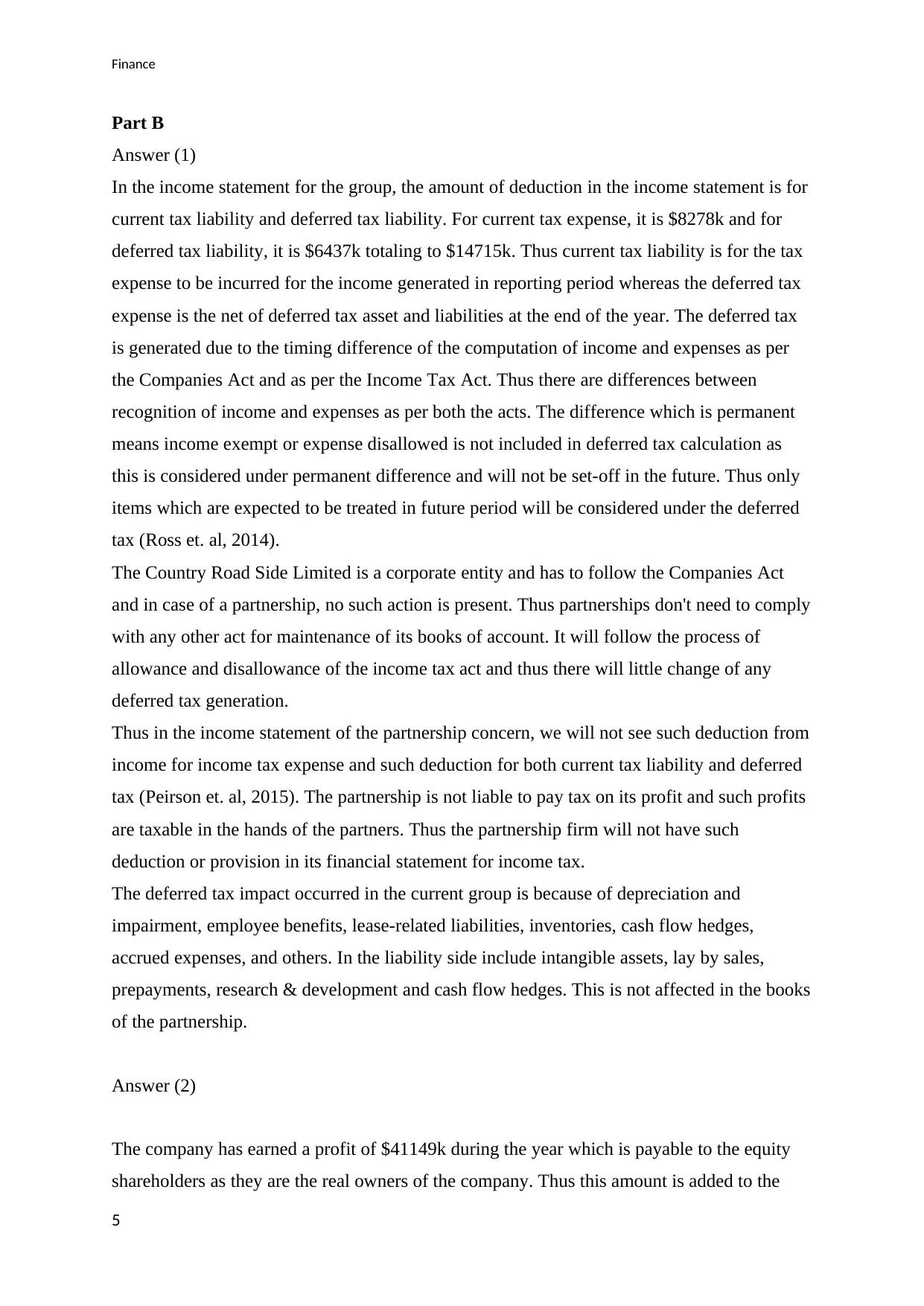
Finance
Part B
Answer (1)
In the income statement for the group, the amount of deduction in the income statement is for
current tax liability and deferred tax liability. For current tax expense, it is $8278k and for
deferred tax liability, it is $6437k totaling to $14715k. Thus current tax liability is for the tax
expense to be incurred for the income generated in reporting period whereas the deferred tax
expense is the net of deferred tax asset and liabilities at the end of the year. The deferred tax
is generated due to the timing difference of the computation of income and expenses as per
the Companies Act and as per the Income Tax Act. Thus there are differences between
recognition of income and expenses as per both the acts. The difference which is permanent
means income exempt or expense disallowed is not included in deferred tax calculation as
this is considered under permanent difference and will not be set-off in the future. Thus only
items which are expected to be treated in future period will be considered under the deferred
tax (Ross et. al, 2014).
The Country Road Side Limited is a corporate entity and has to follow the Companies Act
and in case of a partnership, no such action is present. Thus partnerships don't need to comply
with any other act for maintenance of its books of account. It will follow the process of
allowance and disallowance of the income tax act and thus there will little change of any
deferred tax generation.
Thus in the income statement of the partnership concern, we will not see such deduction from
income for income tax expense and such deduction for both current tax liability and deferred
tax (Peirson et. al, 2015). The partnership is not liable to pay tax on its profit and such profits
are taxable in the hands of the partners. Thus the partnership firm will not have such
deduction or provision in its financial statement for income tax.
The deferred tax impact occurred in the current group is because of depreciation and
impairment, employee benefits, lease-related liabilities, inventories, cash flow hedges,
accrued expenses, and others. In the liability side include intangible assets, lay by sales,
prepayments, research & development and cash flow hedges. This is not affected in the books
of the partnership.
Answer (2)
The company has earned a profit of $41149k during the year which is payable to the equity
shareholders as they are the real owners of the company. Thus this amount is added to the
5
Part B
Answer (1)
In the income statement for the group, the amount of deduction in the income statement is for
current tax liability and deferred tax liability. For current tax expense, it is $8278k and for
deferred tax liability, it is $6437k totaling to $14715k. Thus current tax liability is for the tax
expense to be incurred for the income generated in reporting period whereas the deferred tax
expense is the net of deferred tax asset and liabilities at the end of the year. The deferred tax
is generated due to the timing difference of the computation of income and expenses as per
the Companies Act and as per the Income Tax Act. Thus there are differences between
recognition of income and expenses as per both the acts. The difference which is permanent
means income exempt or expense disallowed is not included in deferred tax calculation as
this is considered under permanent difference and will not be set-off in the future. Thus only
items which are expected to be treated in future period will be considered under the deferred
tax (Ross et. al, 2014).
The Country Road Side Limited is a corporate entity and has to follow the Companies Act
and in case of a partnership, no such action is present. Thus partnerships don't need to comply
with any other act for maintenance of its books of account. It will follow the process of
allowance and disallowance of the income tax act and thus there will little change of any
deferred tax generation.
Thus in the income statement of the partnership concern, we will not see such deduction from
income for income tax expense and such deduction for both current tax liability and deferred
tax (Peirson et. al, 2015). The partnership is not liable to pay tax on its profit and such profits
are taxable in the hands of the partners. Thus the partnership firm will not have such
deduction or provision in its financial statement for income tax.
The deferred tax impact occurred in the current group is because of depreciation and
impairment, employee benefits, lease-related liabilities, inventories, cash flow hedges,
accrued expenses, and others. In the liability side include intangible assets, lay by sales,
prepayments, research & development and cash flow hedges. This is not affected in the books
of the partnership.
Answer (2)
The company has earned a profit of $41149k during the year which is payable to the equity
shareholders as they are the real owners of the company. Thus this amount is added to the
5
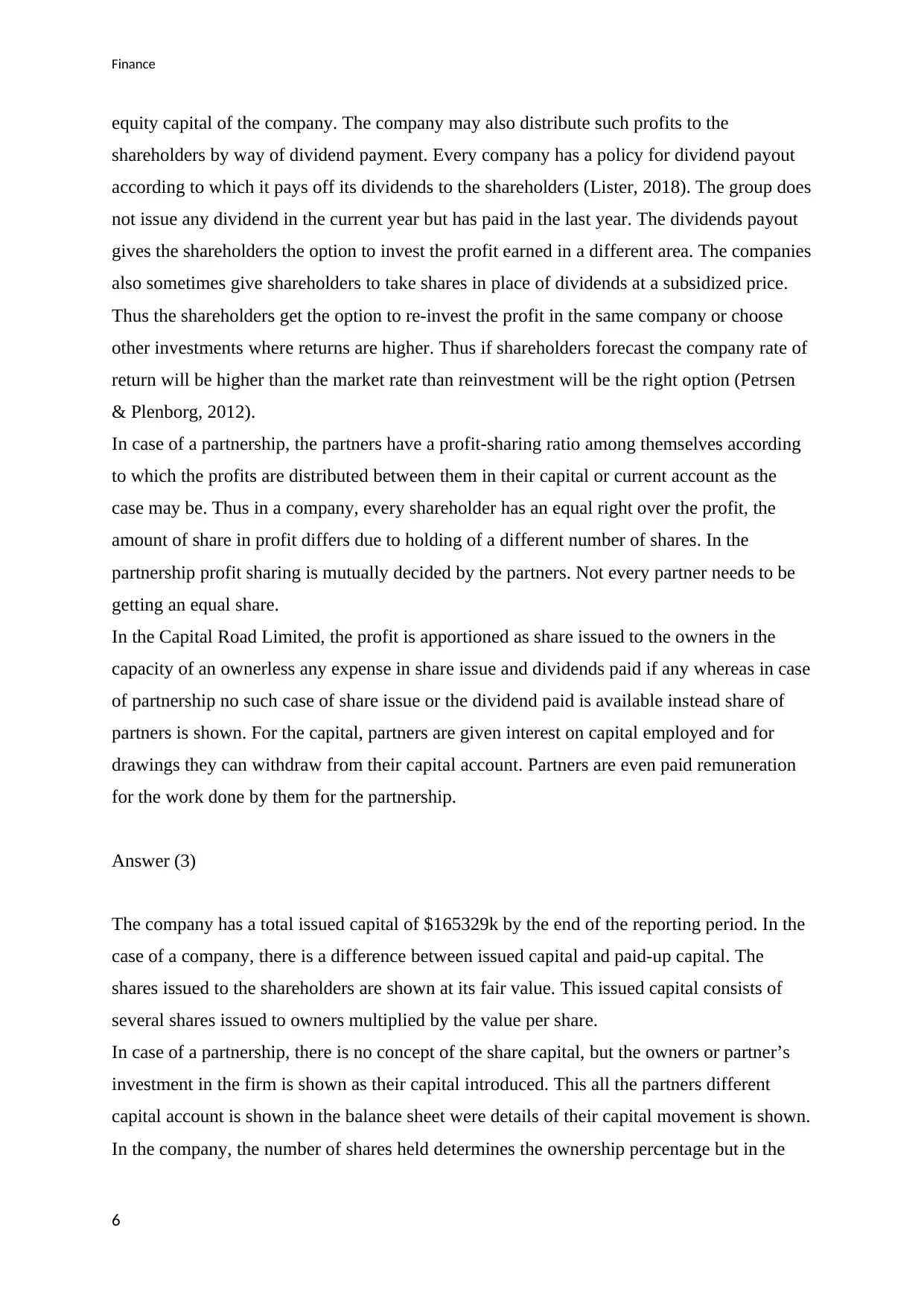
Finance
equity capital of the company. The company may also distribute such profits to the
shareholders by way of dividend payment. Every company has a policy for dividend payout
according to which it pays off its dividends to the shareholders (Lister, 2018). The group does
not issue any dividend in the current year but has paid in the last year. The dividends payout
gives the shareholders the option to invest the profit earned in a different area. The companies
also sometimes give shareholders to take shares in place of dividends at a subsidized price.
Thus the shareholders get the option to re-invest the profit in the same company or choose
other investments where returns are higher. Thus if shareholders forecast the company rate of
return will be higher than the market rate than reinvestment will be the right option (Petrsen
& Plenborg, 2012).
In case of a partnership, the partners have a profit-sharing ratio among themselves according
to which the profits are distributed between them in their capital or current account as the
case may be. Thus in a company, every shareholder has an equal right over the profit, the
amount of share in profit differs due to holding of a different number of shares. In the
partnership profit sharing is mutually decided by the partners. Not every partner needs to be
getting an equal share.
In the Capital Road Limited, the profit is apportioned as share issued to the owners in the
capacity of an ownerless any expense in share issue and dividends paid if any whereas in case
of partnership no such case of share issue or the dividend paid is available instead share of
partners is shown. For the capital, partners are given interest on capital employed and for
drawings they can withdraw from their capital account. Partners are even paid remuneration
for the work done by them for the partnership.
Answer (3)
The company has a total issued capital of $165329k by the end of the reporting period. In the
case of a company, there is a difference between issued capital and paid-up capital. The
shares issued to the shareholders are shown at its fair value. This issued capital consists of
several shares issued to owners multiplied by the value per share.
In case of a partnership, there is no concept of the share capital, but the owners or partner’s
investment in the firm is shown as their capital introduced. This all the partners different
capital account is shown in the balance sheet were details of their capital movement is shown.
In the company, the number of shares held determines the ownership percentage but in the
6
equity capital of the company. The company may also distribute such profits to the
shareholders by way of dividend payment. Every company has a policy for dividend payout
according to which it pays off its dividends to the shareholders (Lister, 2018). The group does
not issue any dividend in the current year but has paid in the last year. The dividends payout
gives the shareholders the option to invest the profit earned in a different area. The companies
also sometimes give shareholders to take shares in place of dividends at a subsidized price.
Thus the shareholders get the option to re-invest the profit in the same company or choose
other investments where returns are higher. Thus if shareholders forecast the company rate of
return will be higher than the market rate than reinvestment will be the right option (Petrsen
& Plenborg, 2012).
In case of a partnership, the partners have a profit-sharing ratio among themselves according
to which the profits are distributed between them in their capital or current account as the
case may be. Thus in a company, every shareholder has an equal right over the profit, the
amount of share in profit differs due to holding of a different number of shares. In the
partnership profit sharing is mutually decided by the partners. Not every partner needs to be
getting an equal share.
In the Capital Road Limited, the profit is apportioned as share issued to the owners in the
capacity of an ownerless any expense in share issue and dividends paid if any whereas in case
of partnership no such case of share issue or the dividend paid is available instead share of
partners is shown. For the capital, partners are given interest on capital employed and for
drawings they can withdraw from their capital account. Partners are even paid remuneration
for the work done by them for the partnership.
Answer (3)
The company has a total issued capital of $165329k by the end of the reporting period. In the
case of a company, there is a difference between issued capital and paid-up capital. The
shares issued to the shareholders are shown at its fair value. This issued capital consists of
several shares issued to owners multiplied by the value per share.
In case of a partnership, there is no concept of the share capital, but the owners or partner’s
investment in the firm is shown as their capital introduced. This all the partners different
capital account is shown in the balance sheet were details of their capital movement is shown.
In the company, the number of shares held determines the ownership percentage but in the
6
⊘ This is a preview!⊘
Do you want full access?
Subscribe today to unlock all pages.

Trusted by 1+ million students worldwide
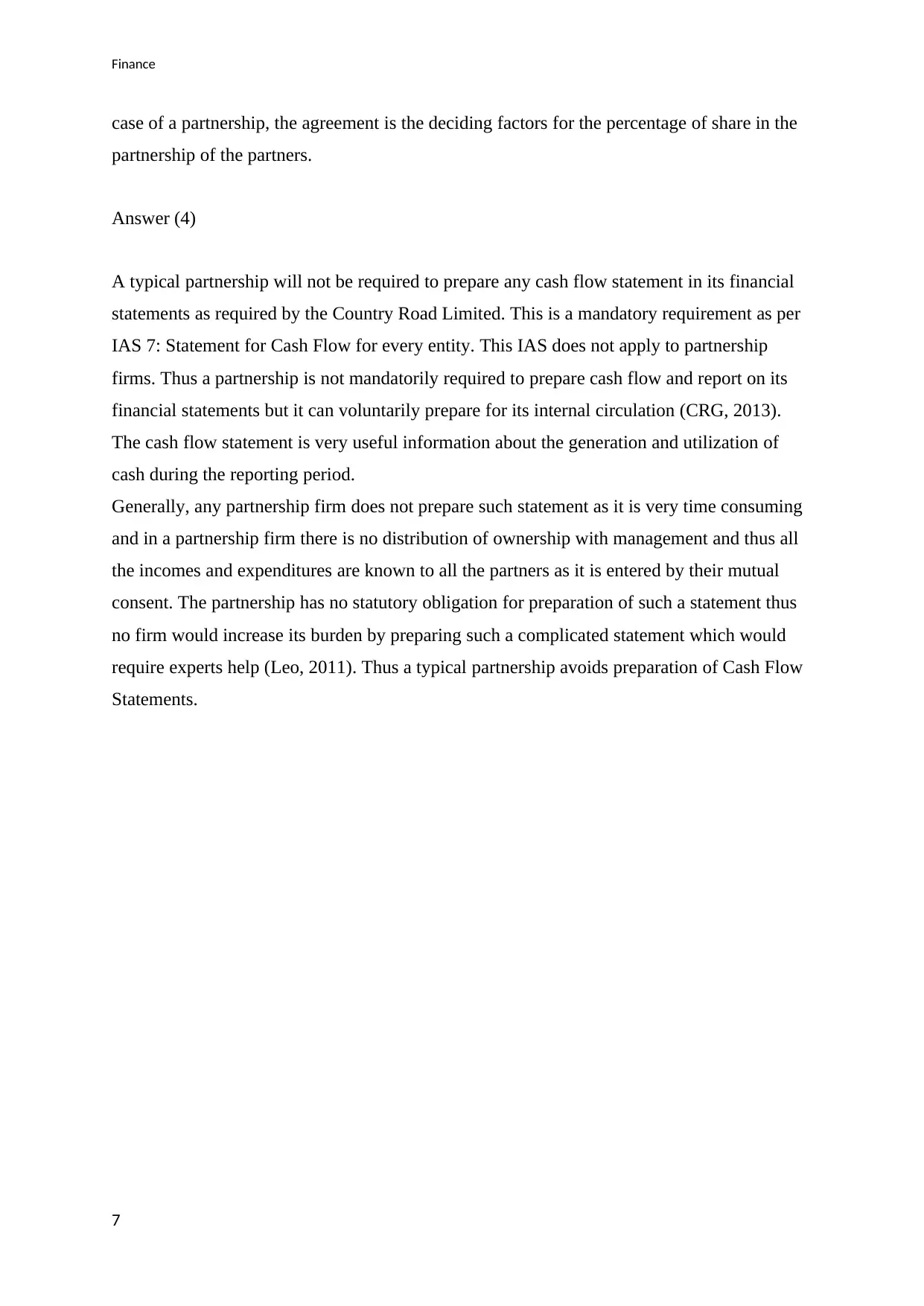
Finance
case of a partnership, the agreement is the deciding factors for the percentage of share in the
partnership of the partners.
Answer (4)
A typical partnership will not be required to prepare any cash flow statement in its financial
statements as required by the Country Road Limited. This is a mandatory requirement as per
IAS 7: Statement for Cash Flow for every entity. This IAS does not apply to partnership
firms. Thus a partnership is not mandatorily required to prepare cash flow and report on its
financial statements but it can voluntarily prepare for its internal circulation (CRG, 2013).
The cash flow statement is very useful information about the generation and utilization of
cash during the reporting period.
Generally, any partnership firm does not prepare such statement as it is very time consuming
and in a partnership firm there is no distribution of ownership with management and thus all
the incomes and expenditures are known to all the partners as it is entered by their mutual
consent. The partnership has no statutory obligation for preparation of such a statement thus
no firm would increase its burden by preparing such a complicated statement which would
require experts help (Leo, 2011). Thus a typical partnership avoids preparation of Cash Flow
Statements.
7
case of a partnership, the agreement is the deciding factors for the percentage of share in the
partnership of the partners.
Answer (4)
A typical partnership will not be required to prepare any cash flow statement in its financial
statements as required by the Country Road Limited. This is a mandatory requirement as per
IAS 7: Statement for Cash Flow for every entity. This IAS does not apply to partnership
firms. Thus a partnership is not mandatorily required to prepare cash flow and report on its
financial statements but it can voluntarily prepare for its internal circulation (CRG, 2013).
The cash flow statement is very useful information about the generation and utilization of
cash during the reporting period.
Generally, any partnership firm does not prepare such statement as it is very time consuming
and in a partnership firm there is no distribution of ownership with management and thus all
the incomes and expenditures are known to all the partners as it is entered by their mutual
consent. The partnership has no statutory obligation for preparation of such a statement thus
no firm would increase its burden by preparing such a complicated statement which would
require experts help (Leo, 2011). Thus a typical partnership avoids preparation of Cash Flow
Statements.
7
Paraphrase This Document
Need a fresh take? Get an instant paraphrase of this document with our AI Paraphraser
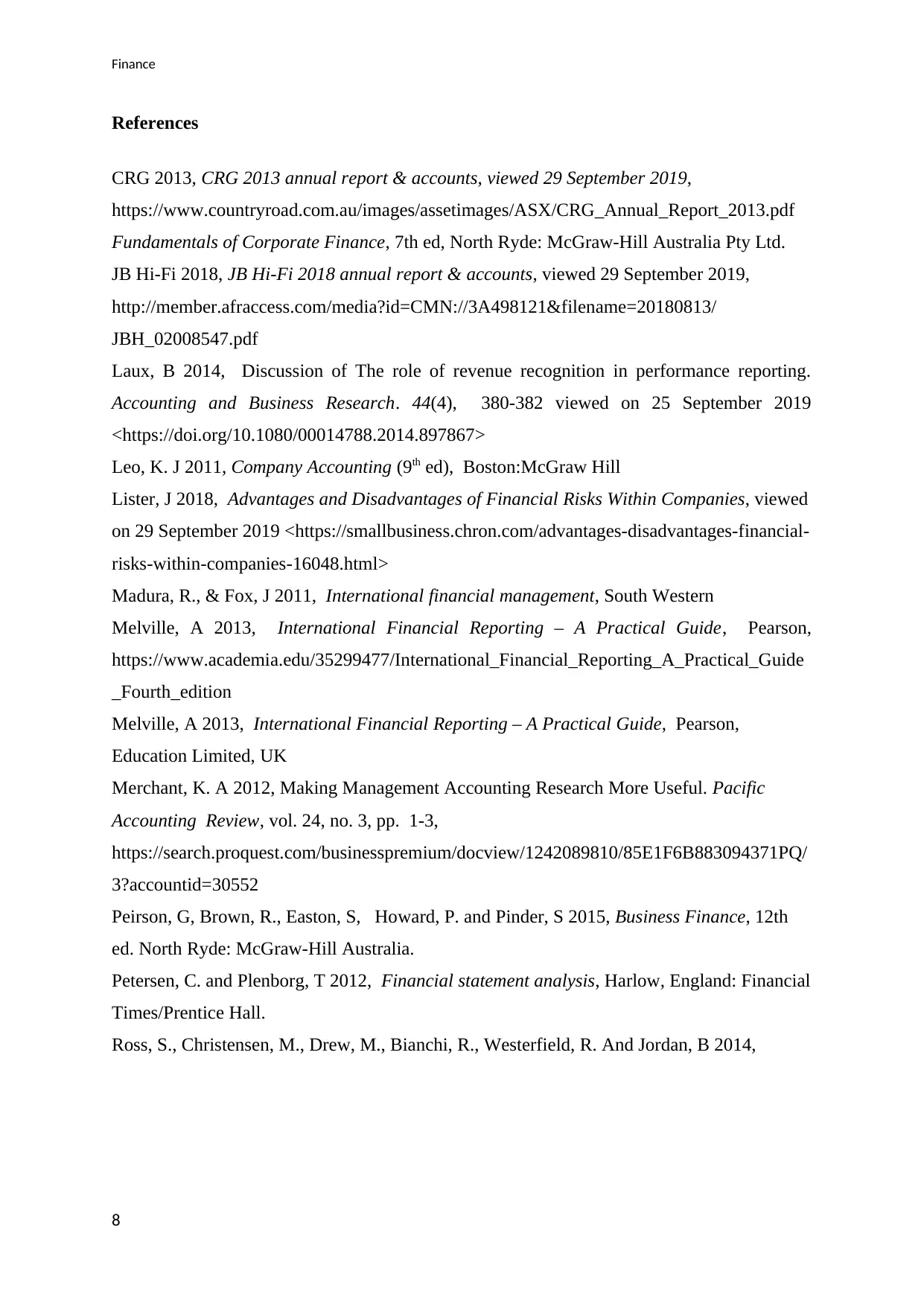
Finance
References
CRG 2013, CRG 2013 annual report & accounts, viewed 29 September 2019,
https://www.countryroad.com.au/images/assetimages/ASX/CRG_Annual_Report_2013.pdf
Fundamentals of Corporate Finance, 7th ed, North Ryde: McGraw-Hill Australia Pty Ltd.
JB Hi-Fi 2018, JB Hi-Fi 2018 annual report & accounts, viewed 29 September 2019,
http://member.afraccess.com/media?id=CMN://3A498121&filename=20180813/
JBH_02008547.pdf
Laux, B 2014, Discussion of The role of revenue recognition in performance reporting.
Accounting and Business Research. 44(4), 380-382 viewed on 25 September 2019
<https://doi.org/10.1080/00014788.2014.897867>
Leo, K. J 2011, Company Accounting (9th ed), Boston:McGraw Hill
Lister, J 2018, Advantages and Disadvantages of Financial Risks Within Companies, viewed
on 29 September 2019 <https://smallbusiness.chron.com/advantages-disadvantages-financial-
risks-within-companies-16048.html>
Madura, R., & Fox, J 2011, International financial management, South Western
Melville, A 2013, International Financial Reporting – A Practical Guide, Pearson,
https://www.academia.edu/35299477/International_Financial_Reporting_A_Practical_Guide
_Fourth_edition
Melville, A 2013, International Financial Reporting – A Practical Guide, Pearson,
Education Limited, UK
Merchant, K. A 2012, Making Management Accounting Research More Useful. Pacific
Accounting Review, vol. 24, no. 3, pp. 1-3,
https://search.proquest.com/businesspremium/docview/1242089810/85E1F6B883094371PQ/
3?accountid=30552
Peirson, G, Brown, R., Easton, S, Howard, P. and Pinder, S 2015, Business Finance, 12th
ed. North Ryde: McGraw-Hill Australia.
Petersen, C. and Plenborg, T 2012, Financial statement analysis, Harlow, England: Financial
Times/Prentice Hall.
Ross, S., Christensen, M., Drew, M., Bianchi, R., Westerfield, R. And Jordan, B 2014,
8
References
CRG 2013, CRG 2013 annual report & accounts, viewed 29 September 2019,
https://www.countryroad.com.au/images/assetimages/ASX/CRG_Annual_Report_2013.pdf
Fundamentals of Corporate Finance, 7th ed, North Ryde: McGraw-Hill Australia Pty Ltd.
JB Hi-Fi 2018, JB Hi-Fi 2018 annual report & accounts, viewed 29 September 2019,
http://member.afraccess.com/media?id=CMN://3A498121&filename=20180813/
JBH_02008547.pdf
Laux, B 2014, Discussion of The role of revenue recognition in performance reporting.
Accounting and Business Research. 44(4), 380-382 viewed on 25 September 2019
<https://doi.org/10.1080/00014788.2014.897867>
Leo, K. J 2011, Company Accounting (9th ed), Boston:McGraw Hill
Lister, J 2018, Advantages and Disadvantages of Financial Risks Within Companies, viewed
on 29 September 2019 <https://smallbusiness.chron.com/advantages-disadvantages-financial-
risks-within-companies-16048.html>
Madura, R., & Fox, J 2011, International financial management, South Western
Melville, A 2013, International Financial Reporting – A Practical Guide, Pearson,
https://www.academia.edu/35299477/International_Financial_Reporting_A_Practical_Guide
_Fourth_edition
Melville, A 2013, International Financial Reporting – A Practical Guide, Pearson,
Education Limited, UK
Merchant, K. A 2012, Making Management Accounting Research More Useful. Pacific
Accounting Review, vol. 24, no. 3, pp. 1-3,
https://search.proquest.com/businesspremium/docview/1242089810/85E1F6B883094371PQ/
3?accountid=30552
Peirson, G, Brown, R., Easton, S, Howard, P. and Pinder, S 2015, Business Finance, 12th
ed. North Ryde: McGraw-Hill Australia.
Petersen, C. and Plenborg, T 2012, Financial statement analysis, Harlow, England: Financial
Times/Prentice Hall.
Ross, S., Christensen, M., Drew, M., Bianchi, R., Westerfield, R. And Jordan, B 2014,
8
1 out of 8
Related Documents
Your All-in-One AI-Powered Toolkit for Academic Success.
+13062052269
info@desklib.com
Available 24*7 on WhatsApp / Email
![[object Object]](/_next/static/media/star-bottom.7253800d.svg)
Unlock your academic potential
Copyright © 2020–2025 A2Z Services. All Rights Reserved. Developed and managed by ZUCOL.





